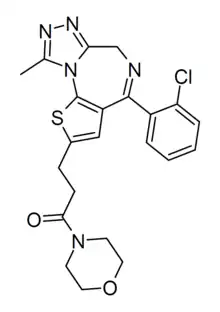Apafant
 | |
| Identifiers | |
|---|---|
IUPAC name
| |
| CAS Number | |
| PubChem CID | |
| IUPHAR/BPS | |
| ChemSpider | |
| UNII | |
| KEGG | |
| ChEBI | |
| ChEMBL | |
| CompTox Dashboard (EPA) | |
| ECHA InfoCard | 100.220.442 |
| Chemical and physical data | |
| Formula | C22H22ClN5O2S |
| Molar mass | 455.96 g·mol−1 |
| 3D model (JSmol) | |
SMILES
| |
InChI
| |
Apafant (WEB-2086, LSM-2613) is a drug which acts as a potent and selective inhibitor of the phospholipid mediator platelet-activating factor (PAF). It was developed by structural modification of the thienotriazolodiazepine sedative drug brotizolam and demonstrated that PAF inhibitory actions could be separated from activity at the benzodiazepine receptor. Apafant was investigated for several applications involving inflammatory responses such as asthma and conjunctivitis but was never adopted for medical use, however it continues to be used in pharmacology research.[1][2][3][4]
References
- ↑ Casals-Stenzel J (December 1991). "Thieno-triazolo-1,4-diazepines as antagonists of platelet-activating factor: present status". Lipids. 26 (12): 1157–1161. doi:10.1007/BF02536522. PMID 1668111. S2CID 4053407.
- ↑ Brecht HM, Adamus WS, Heuer HO, Birke FW, Kempe ER (January 1991). "Pharmacodynamics, pharmacokinetics and safety profile of the new platelet-activating factor antagonist apafant in man". Arzneimittel-Forschung. 41 (1): 51–59. PMID 1646613.
- ↑ Ikegami K, Hata H, Fuchigami J, Tanaka K, Kohjimoto Y, Uchida S, Tasaka K (June 1997). "Apafant (a PAF receptor antagonist) suppresses the early and late airway responses in guinea pigs: a comparison with antiasthmatic drugs". European Journal of Pharmacology. 328 (1): 75–81. doi:10.1016/s0014-2999(97)83031-2. PMID 9203572.
- ↑ Kato M, Imoto K, Miyake H, Oda T, Miyaji S, Nakamura M (August 2004). "Apafant, a potent platelet-activating factor antagonist, blocks eosinophil activation and is effective in the chronic phase of experimental allergic conjunctivitis in guinea pigs". Journal of Pharmacological Sciences. 95 (4): 435–442. doi:10.1254/jphs.fp0040265. PMID 15286429. S2CID 34872524.
This article is issued from Offline. The text is licensed under Creative Commons - Attribution - Sharealike. Additional terms may apply for the media files.